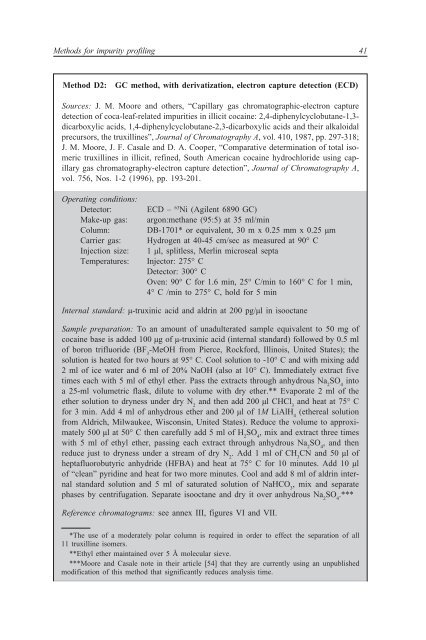methods for impurity profiling of heroin and cocaine - United Nations ...
methods for impurity profiling of heroin and cocaine - United Nations ...
methods for impurity profiling of heroin and cocaine - United Nations ...
Create successful ePaper yourself
Turn your PDF publications into a flip-book with our unique Google optimized e-Paper software.
Methods <strong>for</strong> <strong>impurity</strong> <strong>pr<strong>of</strong>iling</strong> 41<br />
Method D2: GC method, with derivatization, electron capture detection (ECD)<br />
Sources: J. M. Moore <strong>and</strong> others, “Capillary gas chromatographic-electron capture<br />
detection <strong>of</strong> coca-leaf-related impurities in illicit <strong>cocaine</strong>: 2,4-diphenylcyclobutane-1,3dicarboxylic<br />
acids, 1,4-diphenylcyclobutane-2,3-dicarboxylic acids <strong>and</strong> their alkaloidal<br />
precursors, the truxillines”, Journal <strong>of</strong> Chromatography A, vol. 410, 1987, pp. 297-318;<br />
J. M. Moore, J. F. Casale <strong>and</strong> D. A. Cooper, “Comparative determination <strong>of</strong> total isomeric<br />
truxillines in illicit, refined, South American <strong>cocaine</strong> hydrochloride using capillary<br />
gas chromatography-electron capture detection”, Journal <strong>of</strong> Chromatography A,<br />
vol. 756, Nos. 1-2 (1996), pp. 193-201.<br />
Operating conditions:<br />
Detector: ECD – 63 Ni (Agilent 6890 GC)<br />
Make-up gas: argon:methane (95:5) at 35 ml/min<br />
Column: DB-1701* or equivalent, 30 m x 0.25 mm x 0.25 µm<br />
Carrier gas: Hydrogen at 40-45 cm/sec as measured at 90° C<br />
Injection size: 1 µl, splitless, Merlin microseal septa<br />
Temperatures: Injector: 275° C<br />
Detector: 300° C<br />
Oven: 90° C <strong>for</strong> 1.6 min, 25° C/min to 160° C <strong>for</strong> 1 min,<br />
4° C /min to 275° C, hold <strong>for</strong> 5 min<br />
Internal st<strong>and</strong>ard: µ-truxinic acid <strong>and</strong> aldrin at 200 pg/µl in isooctane<br />
Sample preparation: To an amount <strong>of</strong> unadulterated sample equivalent to 50 mg <strong>of</strong><br />
<strong>cocaine</strong> base is added 100 µg <strong>of</strong> µ-truxinic acid (internal st<strong>and</strong>ard) followed by 0.5 ml<br />
<strong>of</strong> boron trifluoride (BF 3 -MeOH from Pierce, Rock<strong>for</strong>d, Illinois, <strong>United</strong> States); the<br />
solution is heated <strong>for</strong> two hours at 95° C. Cool solution to -10° C <strong>and</strong> with mixing add<br />
2 ml <strong>of</strong> ice water <strong>and</strong> 6 ml <strong>of</strong> 20% NaOH (also at 10° C). Immediately extract five<br />
times each with 5 ml <strong>of</strong> ethyl ether. Pass the extracts through anhydrous Na 2 SO 4 into<br />
a 25-ml volumetric flask, dilute to volume with dry ether.** Evaporate 2 ml <strong>of</strong> the<br />
ether solution to dryness under dry N 2 <strong>and</strong> then add 200 µl CHCl 3 <strong>and</strong> heat at 75° C<br />
<strong>for</strong> 3 min. Add 4 ml <strong>of</strong> anhydrous ether <strong>and</strong> 200 µl <strong>of</strong> 1M LiAlH 4 (ethereal solution<br />
from Aldrich, Milwaukee, Wisconsin, <strong>United</strong> States). Reduce the volume to approximately<br />
500 µl at 50° C then carefully add 5 ml <strong>of</strong> H 2 SO 4 , mix <strong>and</strong> extract three times<br />
with 5 ml <strong>of</strong> ethyl ether, passing each extract through anhydrous Na 2 SO 4 , <strong>and</strong> then<br />
reduce just to dryness under a stream <strong>of</strong> dry N 2 . Add 1 ml <strong>of</strong> CH 3 CN <strong>and</strong> 50 µl <strong>of</strong><br />
heptafluorobutyric anhydride (HFBA) <strong>and</strong> heat at 75° C <strong>for</strong> 10 minutes. Add 10 µl<br />
<strong>of</strong> “clean” pyridine <strong>and</strong> heat <strong>for</strong> two more minutes. Cool <strong>and</strong> add 8 ml <strong>of</strong> aldrin internal<br />
st<strong>and</strong>ard solution <strong>and</strong> 5 ml <strong>of</strong> saturated solution <strong>of</strong> NaHCO 3 , mix <strong>and</strong> separate<br />
phases by centrifugation. Separate isooctane <strong>and</strong> dry it over anhydrous Na 2 SO 4 .***<br />
Reference chromatograms: see annex III, figures VI <strong>and</strong> VII.<br />
*The use <strong>of</strong> a moderately polar column is required in order to effect the separation <strong>of</strong> all<br />
11 truxilline isomers.<br />
**Ethyl ether maintained over 5 Å molecular sieve.<br />
***Moore <strong>and</strong> Casale note in their article [54] that they are currently using an unpublished<br />
modification <strong>of</strong> this method that significantly reduces analysis time.

















